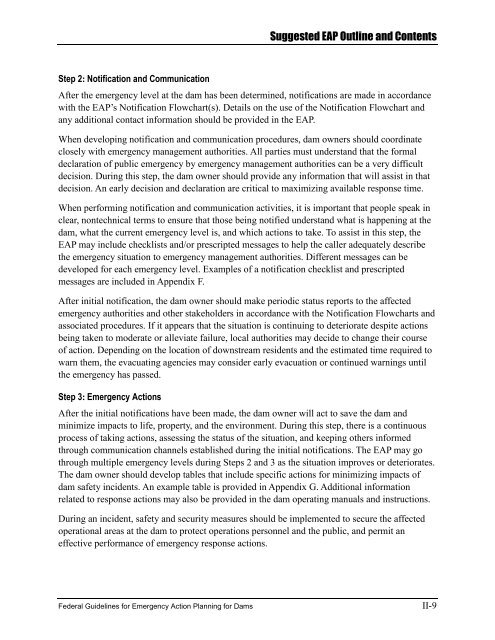Federal Guidelines for Dam Safety: Emergency Action Planning for ...
Federal Guidelines for Dam Safety: Emergency Action Planning for ...
Federal Guidelines for Dam Safety: Emergency Action Planning for ...
Create successful ePaper yourself
Turn your PDF publications into a flip-book with our unique Google optimized e-Paper software.
Suggested EAP Outline and ContentsStep 2: Notification and CommunicationAfter the emergency level at the dam has been determined, notifications are made in accordancewith the EAP’s Notification Flowchart(s). Details on the use of the Notification Flowchart andany additional contact in<strong>for</strong>mation should be provided in the EAP.When developing notification and communication procedures, dam owners should coordinateclosely with emergency management authorities. All parties must understand that the <strong>for</strong>maldeclaration of public emergency by emergency management authorities can be a very difficultdecision. During this step, the dam owner should provide any in<strong>for</strong>mation that will assist in thatdecision. An early decision and declaration are critical to maximizing available response time.When per<strong>for</strong>ming notification and communication activities, it is important that people speak inclear, nontechnical terms to ensure that those being notified understand what is happening at thedam, what the current emergency level is, and which actions to take. To assist in this step, theEAP may include checklists and/or prescripted messages to help the caller adequately describethe emergency situation to emergency management authorities. Different messages can bedeveloped <strong>for</strong> each emergency level. Examples of a notification checklist and prescriptedmessages are included in Appendix F.After initial notification, the dam owner should make periodic status reports to the affectedemergency authorities and other stakeholders in accordance with the Notification Flowcharts andassociated procedures. If it appears that the situation is continuing to deteriorate despite actionsbeing taken to moderate or alleviate failure, local authorities may decide to change their courseof action. Depending on the location of downstream residents and the estimated time required towarn them, the evacuating agencies may consider early evacuation or continued warnings untilthe emergency has passed.Step 3: <strong>Emergency</strong> <strong>Action</strong>sAfter the initial notifications have been made, the dam owner will act to save the dam andminimize impacts to life, property, and the environment. During this step, there is a continuousprocess of taking actions, assessing the status of the situation, and keeping others in<strong>for</strong>medthrough communication channels established during the initial notifications. The EAP may gothrough multiple emergency levels during Steps 2 and 3 as the situation improves or deteriorates.The dam owner should develop tables that include specific actions <strong>for</strong> minimizing impacts ofdam safety incidents. An example table is provided in Appendix G. Additional in<strong>for</strong>mationrelated to response actions may also be provided in the dam operating manuals and instructions.During an incident, safety and security measures should be implemented to secure the affectedoperational areas at the dam to protect operations personnel and the public, and permit aneffective per<strong>for</strong>mance of emergency response actions.<strong>Federal</strong> <strong>Guidelines</strong> <strong>for</strong> <strong>Emergency</strong> <strong>Action</strong> <strong>Planning</strong> <strong>for</strong> <strong>Dam</strong>sII-9
















